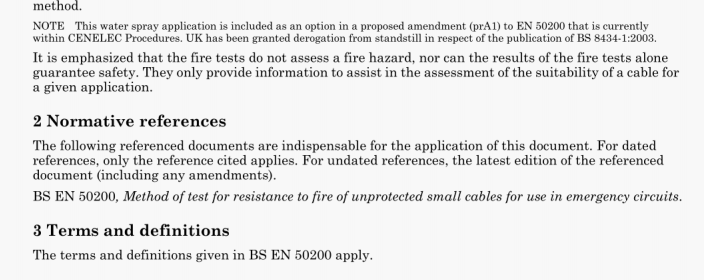Methods of test for assessment of the fire integrity of electric cables

BS 8434-1-2003 pdf free.Methods of test for assessment of the fire integrity of electric cablesMethods of test for assessment of the fire integrity of electric cables – Part 1: Test for unprotected small cables for use in emergency circuits 一 BS EN 50200 with addition of water spray.
The following referenced documents are indispensable for the application of this document. For dated references, only the reference cited applies. For undated references, the latest edition of the referenced document (including any amendments).
BS EN 50200, Method of test for resistance to fire of unprotected sinai! cables for use in emergency circuits.
3 Terms and definitions
The terms and definitions given in HS EN 50200 apply.
4 Duration of survival
4.1 Time
The duration of the test shall be 30 mm (15 mm for the initial fire and impact phase followed by an additional 15 mm for the fire, impact and water phase), during which the cable shall not reach the point of failure.
Conformity to this requirement shall qualify for a 30 mm classification.
NOTE I The 30 mm classification meets the requirement specified in 13S 58.39.1:2002, 26.2d) (see Clause 1 of the present standard).
NOTE 2 Particular product standards or specifications may use the same test protocol, and may contain other durations of test that
do not lead to a classification under this standard. (]
4.2 Point of failure
The provisions of RS EN 50200 shall apply.
5 Test environment
The provisions of 115 EN 50200 shall apply.
6 Test apparatus
6.1 Test equipment. In addition to the provisions of BS EN 50200, the test equipment shall include a water
spray device as described in 6.6.
6.2 Wall and its mounting, conforming to 115 EN 50200.
6.3 continuity checking arrangement, conforming to uS EN 50200.
6.4 Source of heat, conforming to BS EN 50200 except that the nominal burner face width shall be 10 mm.
6.5 Shock producing device, conforming to uS EN 50200.
6.6 Water spray device, consisting of a metallic tube (copper or stainless steel) of nominal thickness 1.00 mm and overall diameter (15.5 ± 1.0) mm, closed at one end and open at the other to allow the inflow of water.
The tube shall have one row of 17 holes of 0.85 mm nominal diameter drilled on 30 mm centres as shown in Figure 1.
The bar shall be positioned centrally with respect to the test sample as shown in Figure 2. It shall be supplied by water at a flow rate of (0.80 0.05) 1/mm.
NOTE 1 The input water pressure should be sufficient to meet the specified water flow rate. This should be verified by volumetric measurement
The tube shall be capable of adjustment such that the resulting water spray is centralized around the burned portion of the test sample.
The use of a metal plate device over the burner to avoid ingress of water is permitted. If a plate is used, the calibration shall be carried out with the metal plate in place.
NOTE 2 A metal plate 0.4 mm thick extending horizontally 12mm from the burner face and fixed 12 mm vertically above the centre line of the burner has been found to be satisfactory.
7 Verification procedure for source of heat
The provisions of BS EN 50200 apply, except that if the metal plate device over the burner is used (see 6.6). it shall be in place for the verification procedure.
8 Test sample
The provisions of BS EN 50200 shall apply.
9 Cable test procedure
9.1 General
The provisions of BS EN 50200 shall apply.
9.2 Procedure for different cable types
The provisions of BS EN 50200 shall apply.
9.3 Ignition and shock production
The provisions of BS EN 50200 shall apply.
9.4 Electrification or optical monitoring
The provisions of BS EN 50200 shall apply.
9.5 Application of water spray
After the required period of exposure in accordance with 9.3. with the flame and shock still being applied. start the water spray in accordance with 6.6.
Continue applying the water for the time required by the relevant requirement for resistance to fire and water.
WARNING If the application of the water extinguishes the flame then, for safety reasons, turn the gas supply off and consider the test invalid.
The point of failure shall be as defined in 4.2.
9.6 End-point
Continue the test either:
a) until 15 min of fire and impact alone, followed by 15 min of fire, impact and water has been completed; or
b) to the point of failure.The point of failure shall be as defined in 4.2.
10 Test report
The test report shall include the following information:
a) the number of this British Standard;
b) full description of cable tested;
c) manufacturer of cable tested;
d) test voltage or test wavelength;
e) any options used in methodology (i.e. type of test wall, mass flow meter), and point of failure mechanism;
f) use of the metal plate with the water spray application;
g) type and disposition of clips supporting cable sample;
h) the actual cable bending radius used for the test;
i) method used for temperature monitoring during the verification procedure;
j) the survival time achieved;
k) The classification, if any, claimed.
NOTE The only classification possible against BS 8434-1 is 30 min.BS 8434-1 pdf free download.Methods of test for assessment of the fire integrity of electric cables